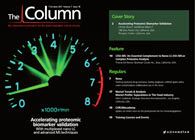Tackling myeloma drug resistance
Acquired drug resistance (ADR) is a major problem when it comes to treating some forms of cancer and one that has been baffling cancer researchers for some time. Now a team at Moffitt Cancer Center in Tampa, Florida, USA are pioneering research using liquid chromatography multiple reaction monitoring (LC-MRM) to track the proteins involved in ADR. Ultimately this could assist in clinical decision-making for developing individualized patient treatments for multiple myeloma and other types of cancer. The research results are published in the October issue of Molecular and Cellular Proteomics.
Acquired drug resistance (ADR) is a major problem when it comes to treating some forms of cancer and one that has been baffling cancer researchers for some time. Now a team at Moffitt Cancer Center in Tampa, Florida, USA are pioneering research using liquid chromatography multiple reaction monitoring (LC-MRM) to track the proteins involved in ADR. Ultimately this could assist in clinical decision-making for developing individualized patient treatments for multiple myeloma and other types of cancer. The research results are published in the October issue of Molecular and Cellular Proteomics.
“Multiple myeloma is an incurable malignancy in the bone marrow,” said John M. Koomen, PhD, assistant member in Molecular Oncology and Experimental Therapeutics and scientific director of Moffitt’s Proteomics Core Facility. “While patients with multiple myeloma initially respond to chemotherapy, they eventually develop drug resistance, so that we can change the therapeutic regimen to meet the needs of the patient.”
LC-MRM has been used successfully to quantify biomarkers of human disease by comparing protein expressions of patients with disease and disease-free controls. It’s also been used to monitor the signalling pathways and networks in cells. In the method developed by the Moffitt researchers, protein separation techniques are coupled with LC-MRM to quantify selected target proteins.
“The potential for LC-MRM to assist treatments across diseases is enormous,” concluded Koomen as it provides new technology that can be used to evaluate cancer that can be applied to research and clinical practice.
This story originally appeared in The Column. Click here to view that issue.
New TRC Facility Accelerates Innovation and Delivery
April 25th 2025We’ve expanded our capabilities with a state-of-the-art, 200,000 sq ft TRC facility in Toronto, completed in 2024 and staffed by over 100 PhD- and MSc-level scientists. This investment enables the development of more innovative compounds, a broader catalogue and custom offering, and streamlined operations for faster delivery. • Our extensive range of over 100,000 high-quality research chemicals—including APIs, metabolites, and impurities in both native and stable isotope-labelled forms—provides essential tools for uncovering molecular disease mechanisms and exploring new opportunities for therapeutic intervention.
New Guide: Characterising Impurity Standards – What Defines “Good Enough?”
April 25th 2025Impurity reference standards (IRSs) are essential for accurately identifying and quantifying impurities in pharmaceutical development and manufacturing. Yet, with limited regulatory guidance on how much characterisation is truly required for different applications, selecting the right standard can be challenging. To help, LGC has developed a new interactive multimedia guide, packed with expert insights to support your decision-making and give you greater confidence when choosing the right IRS for your specific needs.

.png&w=3840&q=75)

.png&w=3840&q=75)



.png&w=3840&q=75)



.png&w=3840&q=75)











